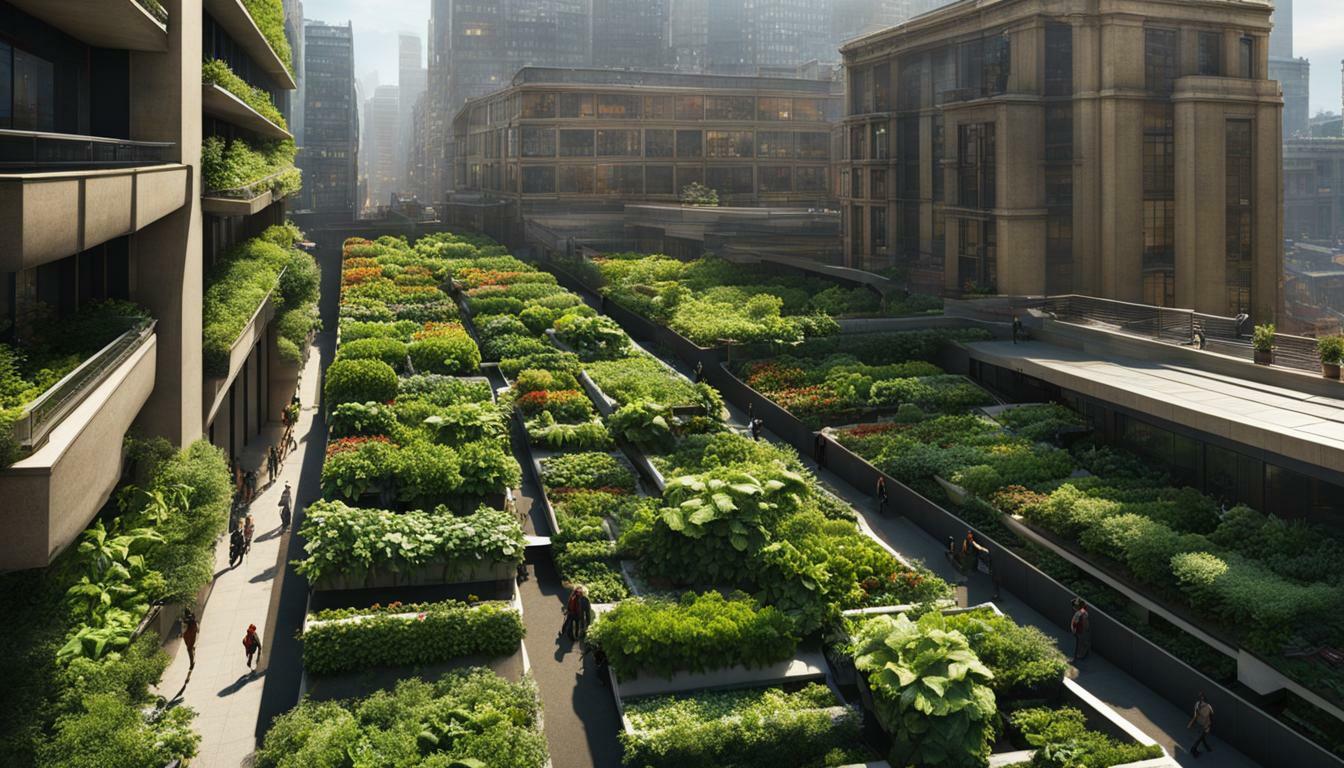If you have limited space in your urban outdoor area but still want to grow your favorite vegetables, these top vertical veg garden ideas are perfect for you. Urban green spaces often lack the room for traditional gardens, but that doesn’t mean you can’t enjoy fresh produce from your own backyard. By utilizing vertical gardening techniques, you can maximize space, promote eco-friendly living, and create a stunning and productive garden.
Key Takeaways:
- Vertical veg garden ideas are ideal for urban green spaces with limited room for traditional gardens.
- By growing vertically, you can optimize space and create a stunning and productive garden.
- Using techniques such as ladder planters, upcycled dressers, and vertical strawberry planters, you can grow a variety of vegetables in a small area.
- Vertical gardening is an eco-friendly way to maximize outdoor space and promote sustainable living.
A Ladder Planter
One of the best vertical gardening ideas for small spaces is a ladder planter, which allows you to grow herbs, flowers, and even veggies together in a compact area. This creative and functional DIY project is a fun and easy way to maximize your gardening space. With a ladder planter, you can take advantage of vertical growing space, making it perfect for urban green spaces where land is limited.
Not only does a ladder planter provide a practical solution for small gardens, but it also adds a unique and aesthetic appeal to your outdoor space. You can customize your ladder planter by painting it in your favorite color or using salvaged materials for a rustic look. The versatility of a ladder planter allows you to experiment with different plant combinations and create a visually stunning vertical garden.
Creating a ladder planter is a straightforward process. Start by selecting a ladder that is sturdy and can support the weight of the plants. Clean and prepare the ladder by sanding it down and applying a protective coat if necessary. Then, attach plant containers or pots to the rungs of the ladder using hooks, brackets, or zip ties. Fill the containers with soil and plant your desired herbs, flowers, or vegetables.
Here is a simple table showcasing the pros and cons of a ladder planter:
| Pros | Cons |
|---|---|
| Maximizes vertical growing space | Limited planting space per container |
| Customizable and aesthetically pleasing | Requires regular maintenance and watering |
| Allows for creative plant combinations | Potential stability issues if not properly secured |
Overall, a ladder planter is a fantastic vertical gardening idea for small spaces. It not only provides a practical solution for maximizing gardening space but also adds a unique and decorative element to your outdoor area. With proper care and maintenance, a ladder planter can transform any urban green space into a vibrant and flourishing garden.
Upcycled Dresser Planter
For those looking for gardening ideas for small spaces, an upcycled dresser planter is a fantastic option to repurpose old furniture into a unique and functional garden. This DIY project allows you to transform an unused or worn-out dresser into a vertical garden that can hold a variety of plants.
To create an upcycled dresser planter, start by removing the drawers from the dresser and determining the layout of your planters. You can use the open spaces where the drawers were or add shelves for additional planting space. Line the drawers or shelves with plastic to protect the dresser from moisture and ensure proper drainage.
Next, fill the planters with potting soil and choose the plants you want to grow. You can opt for a mix of flowers, herbs, or even vegetables, depending on your preferences. Arrange the plants in each planter, making sure to leave enough space for them to grow and thrive. Water the plants regularly and provide adequate sunlight to support their growth.
| Materials Needed: | Step-by-Step Instructions: |
|---|---|
| Dresser | 1. Remove the drawers from the dresser. |
| Plastic liner | 2. Line the drawers or shelves with plastic. |
| Potting soil | 3. Fill the planters with potting soil. |
| Plants | 4. Choose and arrange the plants in each planter. |
| Watering can | 5. Water the plants regularly. |
| Sunlight | 6. Provide adequate sunlight for the plants. |
Not only does an upcycled dresser planter provide a practical solution for gardening in small spaces, but it also adds a unique and visually appealing element to your outdoor space. The repurposed dresser brings a touch of vintage charm and creativity to your garden, making it a conversation starter and a focal point of your outdoor decor.
So, if you’re looking to maximize your gardening space and add a touch of creativity to your outdoor area, consider repurposing an old dresser into a vertical garden. With a little bit of effort and creativity, you can transform an unused piece of furniture into a functional and aesthetically pleasing planter that will breathe new life into your small space garden.
Benefits of an Upcycled Dresser Planter:
- Utilizes unused or worn-out furniture in a sustainable way
- Provides vertical gardening space in small areas
- Adds a unique and creative element to outdoor decor
- Allows for a variety of plants to be grown in a compact space
- Offers the opportunity to repurpose and upcycle materials
By repurposing an old dresser into a vertical planter, you not only create a functional garden but also contribute to sustainable living by giving new life to discarded furniture. Take advantage of this gardening idea for small spaces and enjoy the beauty and productivity of your upcycled dresser planter.
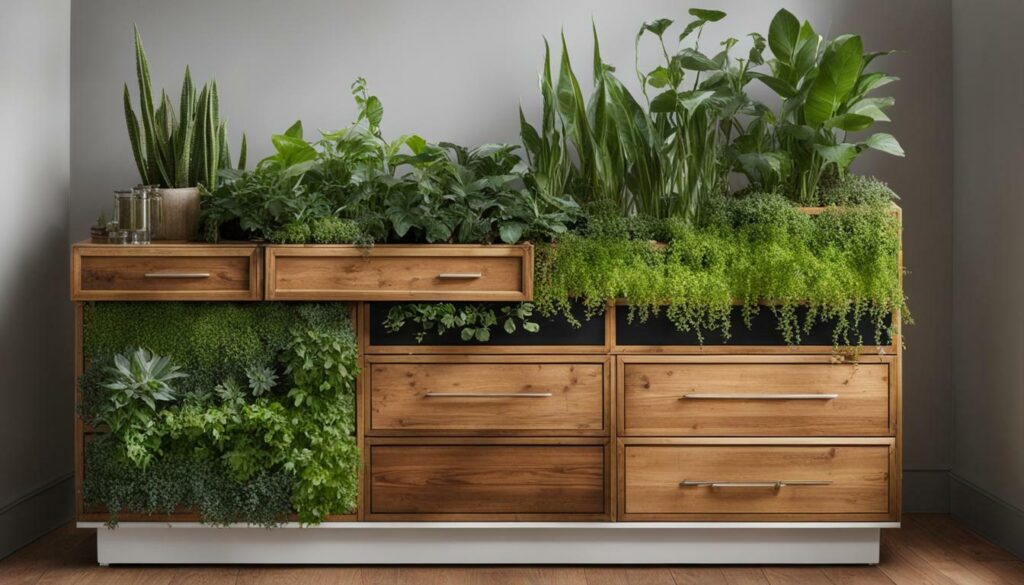
Strawberry Tower Vertical Planter
If you’re looking for vertical garden ideas for small spaces, a strawberry tower vertical planter is an excellent choice to maximize your strawberry yield in a compact area. This vertical gardening idea allows you to grow strawberries vertically, utilizing the vertical space effectively and saving valuable ground space.
Building a strawberry tower vertical planter is relatively simple. All you need are some basic materials and a few easy steps to get started. Here’s a step-by-step guide:
- Start by choosing a suitable container for your strawberry tower. It can be a PVC pipe, a stackable planter, or even a recycled plastic bottle.
- Drill or cut holes in the container at regular intervals. These holes will serve as the planting pockets for your strawberry plants.
- Fill the container with a well-draining potting mix, leaving enough space for the strawberry plants to grow.
- Plant strawberry runners or young plants into the holes, making sure to secure their roots in the potting mix.
- Water the strawberry tower regularly, ensuring that the potting mix remains moist but not waterlogged.
- Place the strawberry tower in a sunny spot, as strawberries thrive in full sun.
- As the strawberry plants grow, they will produce runners that can be trained to fill in the empty pockets of the tower. This will result in a lush and productive strawberry tower.
With a strawberry tower vertical planter, you can enjoy an abundant harvest of fresh and juicy strawberries, even in the smallest of spaces. It’s a practical and visually appealing solution for urban gardeners who want to grow their own food.
Strawberry Tower Care Tips
Here are a few care tips to ensure the success of your strawberry tower vertical planter:
- Regularly check the moisture level of the potting mix and water as needed. Strawberries prefer slightly moist soil.
- Fertilize the strawberry plants every two to three weeks with a balanced organic fertilizer to promote healthy growth and fruit production.
- Remove any weeds or competing plants that may grow in or around the strawberry tower.
- Monitor for pests and diseases, such as aphids or fungal infections, and take appropriate action to prevent or treat them.
- Harvest the ripe strawberries as they become ready, typically when they are fully red and firm.
By following these care tips, your strawberry tower vertical planter will provide you with a bountiful harvest of fresh and delicious strawberries throughout the growing season.
| Advantages of a Strawberry Tower Vertical Planter | Disadvantages of a Strawberry Tower Vertical Planter |
|---|---|
|
|
Overall, a strawberry tower vertical planter is a versatile and practical solution for growing strawberries in small spaces. It offers the opportunity to enjoy a fresh and delicious harvest of strawberries while adding beauty and functionality to your urban garden.
Pipe Vertical Garden
Make the most of your small garden with a pipe vertical garden, which is not only a great way to save space but also serves as functional planters for small gardens. With a pipe vertical garden, you can utilize the vertical space on walls or fences to grow a variety of plants, including herbs, flowers, and even vegetables. This vertical gardening idea is perfect for urban dwellers who have limited garden space but still want to enjoy the benefits of gardening.
Creating a pipe vertical garden is simple and cost-effective. All you need are some PVC pipes, potting soil, and your choice of plants. Start by cutting the PVC pipes into desired lengths and drilling holes in them for drainage. Then, attach the pipes vertically to a wall or fence using brackets or hooks. Fill each pipe with potting soil and plant your favorite herbs or flowers. The pipes act as individual planters, allowing you to grow multiple plants in a small space.
One of the advantages of a pipe vertical garden is its versatility. You can arrange the pipes in different patterns or designs to create a unique and eye-catching display. You can also easily adjust the height of the pipes to accommodate different plant heights. Additionally, the vertical orientation of the pipes allows for better sunlight exposure and airflow, promoting healthy plant growth.
Benefits of a Pipe Vertical Garden:
- Saves space in small gardens
- Maximizes vertical growing area
- Provides functional and attractive planters
- Allows for easy customization and flexibility
- Promotes better sunlight exposure and airflow
Whether you have a tiny balcony or a small backyard, a pipe vertical garden can transform your space into a green oasis. It not only adds beauty to your surroundings but also allows you to grow your own fresh herbs or flowers. So why not give it a try and create your own pipe vertical garden?
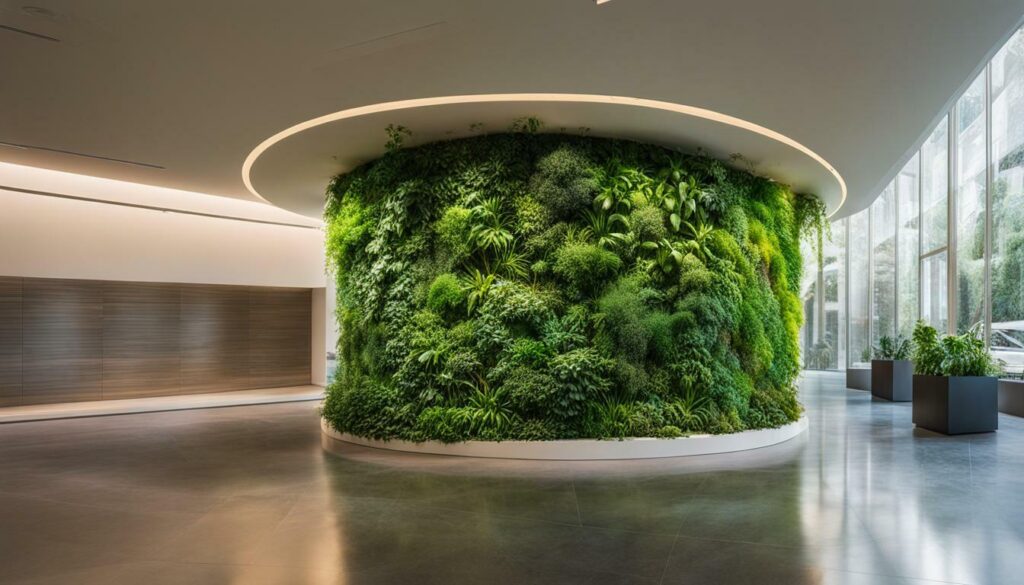
| Plant | Height | Light Requirements | Watering Needs |
|---|---|---|---|
| Herbs (Basil, Rosemary, Thyme) | Varies | Full sun | Regular |
| Flowers (Petunias, Marigolds, Impatiens) | Varies | Full sun to partial shade | Regular |
| Vegetables (Lettuce, Kale, Radishes) | Varies | Full sun to partial shade | Regular |
Terracotta Pot Vertical Fence Garden
Enhance the beauty of your outdoor space with a terracotta pot vertical fence garden, a creative vertical gardening idea that adds charm to any urban garden. This unique and visually appealing garden design allows you to utilize vertical space on your fence, making it perfect for small gardens or limited outdoor areas. By using terracotta pots, you can create a rustic and natural look that complements the surrounding foliage.
To create a terracotta pot vertical fence garden, you will need a few supplies and some basic DIY skills. Here is a step-by-step guide to help you get started:
- Choose the right size and number of terracotta pots for your fence. Consider the available space, the plants you want to grow, and the overall aesthetic you want to achieve.
- Attach metal brackets or hooks to your fence at regular intervals, ensuring they are sturdy enough to support the weight of the pots.
- Secure the terracotta pots to the brackets or hooks, ensuring they are evenly spaced and level.
- Fill the pots with potting soil, leaving enough space for the plants to grow and develop.
- Plant your desired herbs, flowers, or vegetables in each pot, taking into account their specific care requirements.
- Water the plants regularly and provide them with adequate sunlight based on their individual needs.
With a terracotta pot vertical fence garden, you can grow a variety of plants, from herbs like basil and thyme to colorful flowers like petunias and marigolds. The vertical arrangement not only maximizes space but also creates a stunning focal point in your outdoor area.
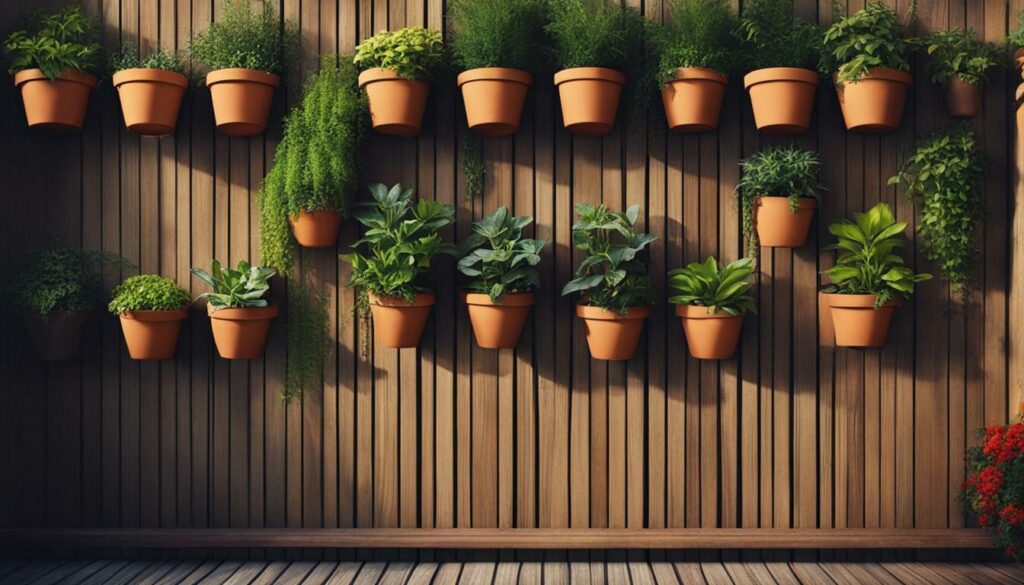
By incorporating a terracotta pot vertical fence garden into your urban garden, you can enjoy the benefits of gardening even in a limited space. It allows you to grow your own herbs, flowers, or vegetables while adding a touch of natural beauty to your outdoor environment. Get creative with your plant selection and arrangement, and watch as your terracotta pot vertical fence garden flourishes.
| Advantages | Maintenance | Cost |
|---|---|---|
| Maximizes vertical space | Regular watering and plant care | Affordable and customizable |
| Creates a unique and visually appealing garden design | Monitoring for pests and diseases | Supplies and plants |
| Adds charm and natural beauty to outdoor space | Weeding and soil maintenance |
Vertical Garden Out of Stacked Boxes
Create a stunning outdoor vertical garden by building a vertical garden out of stacked boxes, a practical and visually appealing way to grow plants in a compact space. This vertical gardening idea allows you to maximize your garden area by utilizing vertical space and creating an eye-catching display of plants. To get started, select sturdy and waterproof boxes that can withstand outdoor conditions. You can use wooden crates, plastic bins, or even repurpose old wooden drawers. Arrange the boxes in a stacked formation, securing them together with zip ties or screws to ensure stability. Next, line the boxes with a layer of landscape fabric or geotextile to prevent soil from spilling out. Fill each box with a high-quality potting mix, ensuring it is well-drained and rich in nutrients. Choose plants that are suitable for vertical growth, such as trailing vines, herbs, or compact vegetables. One popular approach is to create a cascading effect by planting trailing plants in the top box and progressively larger plants in the lower boxes. This creates an aesthetically pleasing visual and allows for better access to sunlight for each plant. To maintain the vertical garden, regular watering is essential. Depending on the types of plants you choose and the weather conditions, you may need to water the vertical garden more frequently than traditional garden beds. Consider installing a drip irrigation system or using self-watering containers to make watering easier and more efficient. Vertical Garden out of Stacked Boxes: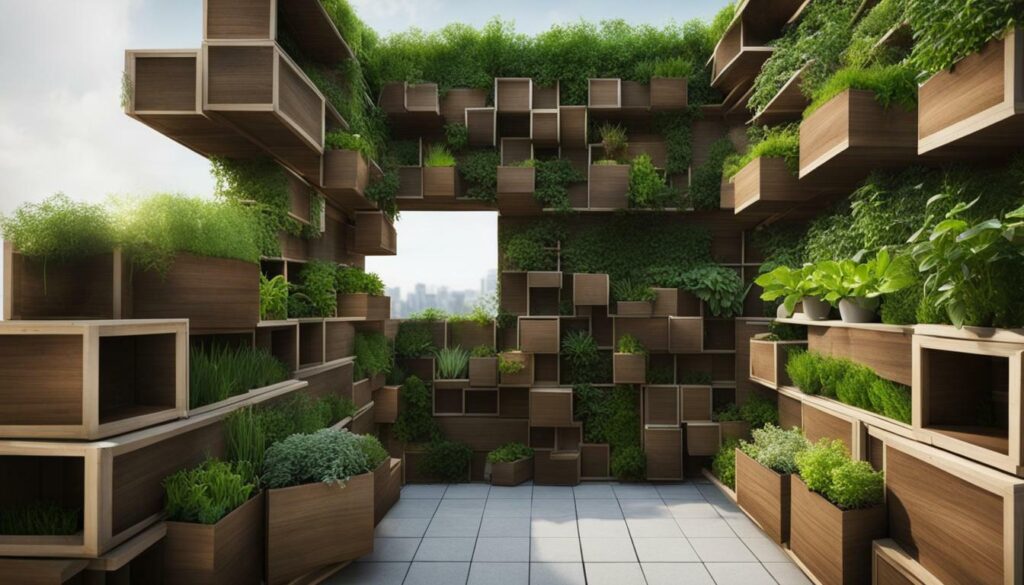 Creating a vertical garden out of stacked boxes is a cost-effective and space-saving solution for urban gardeners or anyone with limited outdoor space. It allows you to enjoy the benefits of gardening and growing your own food, even in small areas. With a little creativity and planning, you can transform a wall or fence into a beautiful vertical garden that adds both beauty and functionality to your outdoor space.
Table: Benefits of Vertical Garden out of Stacked Boxes
| Benefits | Description |
|————————–|———————————————————————————————-|
| Maximizes space | Vertical gardens utilize vertical space, allowing you to grow more plants in a compact area. |
| Visual appeal | Stacked boxes create an eye-catching display of plants, adding beauty to your outdoor space. |
| Cost-effective | Building a vertical garden out of stacked boxes is a budget-friendly option for gardeners. |
| Accessibility | Vertical gardens are easier to maintain and harvest, as plants are at a convenient height. |
| Eco-friendly | Growing your own food in a vertical garden promotes sustainable and eco-friendly living. |
In summary, a vertical garden out of stacked boxes is an innovative way to maximize space and create a visually stunning garden in small areas. Whether you have a small balcony, a limited backyard, or even just a fence or wall, this vertical gardening idea allows you to enjoy the benefits of gardening and bring greenery to your urban green space. Get creative and start building your own vertical garden out of stacked boxes today.
Creating a vertical garden out of stacked boxes is a cost-effective and space-saving solution for urban gardeners or anyone with limited outdoor space. It allows you to enjoy the benefits of gardening and growing your own food, even in small areas. With a little creativity and planning, you can transform a wall or fence into a beautiful vertical garden that adds both beauty and functionality to your outdoor space.
Table: Benefits of Vertical Garden out of Stacked Boxes
| Benefits | Description |
|————————–|———————————————————————————————-|
| Maximizes space | Vertical gardens utilize vertical space, allowing you to grow more plants in a compact area. |
| Visual appeal | Stacked boxes create an eye-catching display of plants, adding beauty to your outdoor space. |
| Cost-effective | Building a vertical garden out of stacked boxes is a budget-friendly option for gardeners. |
| Accessibility | Vertical gardens are easier to maintain and harvest, as plants are at a convenient height. |
| Eco-friendly | Growing your own food in a vertical garden promotes sustainable and eco-friendly living. |
In summary, a vertical garden out of stacked boxes is an innovative way to maximize space and create a visually stunning garden in small areas. Whether you have a small balcony, a limited backyard, or even just a fence or wall, this vertical gardening idea allows you to enjoy the benefits of gardening and bring greenery to your urban green space. Get creative and start building your own vertical garden out of stacked boxes today.
References:
– Source 1: “42 Vertical Gardening Ideas”, available at [source link]. – Source 2: “DIY Vertical Vegetable Garden Ideas”, available at [source link]. – Source 3: “12 Vertical Gardening Ideas”, available at [source link].Vertical Chicken Wire Planter on Fence
Transform your fence into a vertical garden with a vertical chicken wire planter, an innovative gardening planter that adds character to your outdoor space. This unique planter allows you to utilize the vertical space on your fence, making it perfect for small gardens or urban spaces where floor space is limited. The chicken wire design provides a sturdy structure for your plants to grow and climb, creating a beautiful and functional vertical garden.
Creating a vertical chicken wire planter is simple and can be done with just a few materials. Start by attaching a piece of chicken wire to your fence, ensuring that it is securely fastened. Then, fill the planter with soil and plant your desired vegetables, herbs, or flowers. As the plants grow, they will naturally climb the chicken wire, creating a stunning display of greenery on your fence.
This vertical gardening idea not only maximizes your gardening space but also adds visual interest to your outdoor area. The vertical chicken wire planter allows you to grow a variety of plants in a small space, making it ideal for urban gardens or areas with limited room for traditional gardening. Plus, the planter is easily customizable, allowing you to create a unique and personalized garden that suits your style.
Benefits of a Vertical Chicken Wire Planter on Fence:
- Maximizes vertical space on your fence
- Allows you to grow a variety of plants in a small space
- Adds visual interest and character to your outdoor area
- Provides a sturdy structure for plants to grow and climb
- Easily customizable to suit your style and preferences
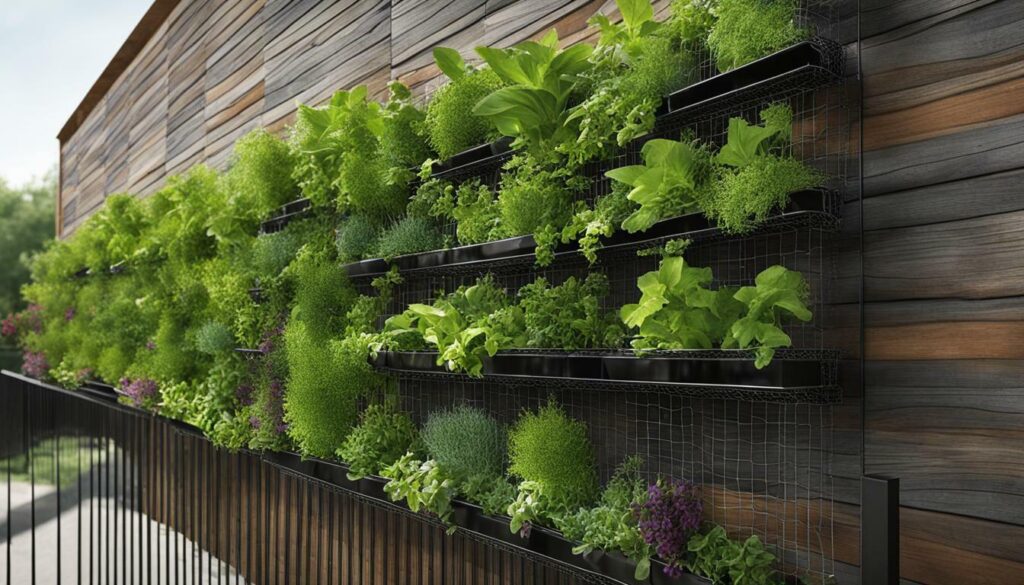
| Advantages | Disadvantages |
|---|---|
| Maximizes vertical space | Requires proper fastening to ensure stability |
| Allows for a variety of plants to be grown | May require frequent watering due to limited soil volume |
| Adds visual interest to outdoor space | May require additional support for heavier plants |
| Customizable to suit individual style | Requires regular maintenance and pruning |
In conclusion, a vertical chicken wire planter on your fence is a creative and practical way to maximize space and create a stunning vertical garden in your outdoor area. By utilizing the vertical space on your fence, you can grow a variety of plants in a small space, adding beauty and character to your garden. Whether you have a small urban garden or just want to make the most of your limited outdoor space, a vertical chicken wire planter is a fantastic option for creating a vertical garden.
Outdoor Shower Caddy Vertical Planter
If you’re looking for plans for a vertical garden, consider creating an outdoor shower caddy vertical planter, a unique and functional way to grow plants in a small outdoor space. This vertical gardening idea utilizes a shower caddy as a hanging garden, providing a convenient and organized way to display and nurture your plants.
The outdoor shower caddy vertical planter is easy to set up and requires minimal materials. Simply attach the shower caddy to a sturdy surface, such as a fence or wall, using screws or hooks. Fill the compartments of the caddy with potting soil and plant your desired herbs, flowers, or vegetables. The compartments of the caddy act as individual planters, allowing you to grow multiple varieties of plants in a compact area.
This vertical gardening idea is not only practical but also aesthetically pleasing. The shower caddy, typically made of rust-resistant materials such as plastic or metal, adds a unique touch to your outdoor space. You can choose to paint the caddy in vibrant colors to create a visually striking vertical garden. The vertical arrangement of the plants in the shower caddy also adds depth and dimension to your outdoor area.
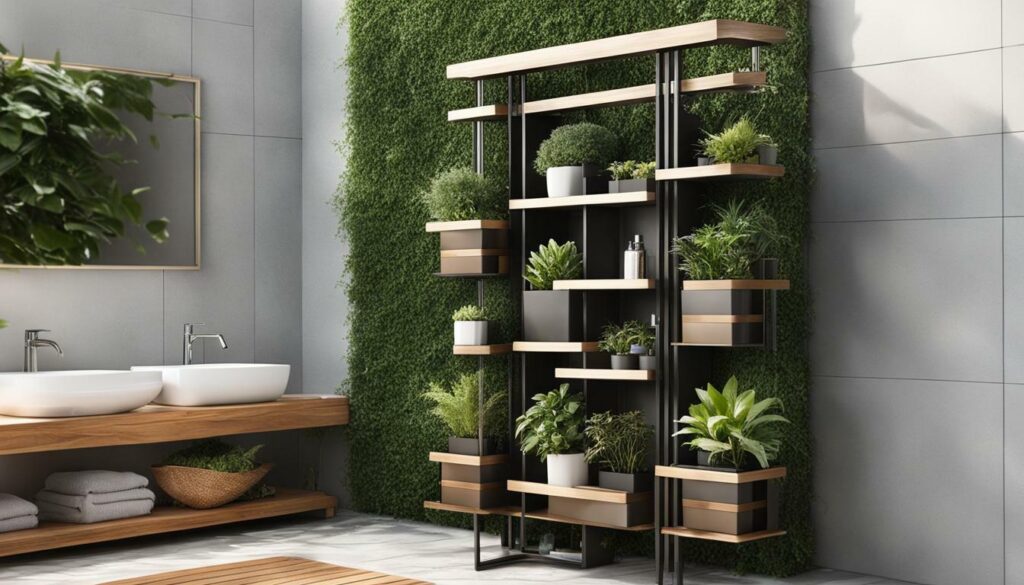
With an outdoor shower caddy vertical planter, you can easily access and maintain your plants. The compartments of the caddy provide sufficient space for plant roots to grow, and the drainage holes prevent overwatering. Additionally, the vertical orientation of the plants allows for efficient sunlight exposure, promoting healthy growth.
Whether you have a small balcony, patio, or backyard, an outdoor shower caddy vertical planter is a versatile gardening solution. It maximizes your available space, allowing you to enjoy the benefits of a garden even in a limited area. So, get creative and transform your outdoor space with this innovative vertical gardening idea.
| Advantages of Outdoor Shower Caddy Vertical Planter |
|---|
| Maximizes space in small outdoor areas |
| Organizes and displays plants in an efficient manner |
| Easy to set up and maintain |
| Aesthetically pleasing and adds depth to outdoor space |
| Allows for efficient sunlight exposure and proper drainage |
Pallet Garden Planter
Embrace a vertical garden system by repurposing pallets into a pallet garden planter, a creative and eco-friendly way to grow aromatic herbs in your outdoor space. Pallet garden planters are a popular choice for small gardens or balconies where space is limited. Not only do they provide a functional solution for growing herbs, but they also add a rustic and charming aesthetic to your outdoor area. To create a pallet garden planter, start by securing the pallet vertically against a wall or fence. This can be done by attaching metal brackets or using sturdy hooks. Make sure the pallet is securely fastened to prevent it from falling or wobbling. Next, fill the gaps between the pallet slats with landscaping fabric or burlap to keep the soil from falling through. This will create individual pockets for planting herbs. Choose a high-quality potting mix and fill the pockets with soil, leaving enough space for the herbs to grow. Now comes the fun part – planting your favorite aromatic herbs! Consider herbs like basil, rosemary, mint, and thyme, as they not only smell delightful but also offer a variety of flavors for your culinary creations. Place each herb plant in the designated pocket and gently press the soil around it to secure it in place. To maintain your pallet garden planter, ensure regular watering and occasional fertilization to keep your herbs thriving. Remember to harvest your herbs regularly to encourage growth and prevent the plants from becoming overcrowded. Enjoy the convenience of having fresh herbs right at your fingertips whenever you need them for cooking or garnishing your dishes.| Advantages of a Pallet Garden Planter |
|---|
| 1. Maximizes vertical space |
| 2. Ideal for small gardens or balconies |
| 3. Adds a rustic and charming aesthetic |
| 4. Allows for easy access to fresh herbs |
| 5. Repurposes and recycles pallets |
Quote:
“A pallet garden planter is not only a great way to grow herbs but also a sustainable way to repurpose materials and reduce waste.”With a pallet garden planter, you can transform your outdoor space into a flourishing herb garden, even in the smallest of areas. Whether you have a balcony, a patio, or a tiny backyard, vertical gardening with a pallet garden planter allows you to make the most of your available space. Enjoy the convenience and beauty of fresh herbs right outside your door while embracing a more eco-friendly and sustainable lifestyle.
Hanging Kitchen Garden
Bring the beauty of nature into your kitchen with a hanging kitchen garden, one of the best vertical gardening ideas that adds a touch of green to your indoor space. Whether you have a small apartment or limited outdoor space, a hanging kitchen garden allows you to grow fresh herbs and vegetables right in your own kitchen. Not only does it provide you with a convenient and accessible source of ingredients for your cooking, but it also adds a decorative element to your kitchen decor.
Creating a hanging kitchen garden is simple and requires minimal space. You can use a variety of containers such as hanging baskets, mason jars, or wall-mounted planters to hang your herbs and vegetables. Choose plants that thrive indoors and require minimal care, such as basil, parsley, mint, or cherry tomatoes. Make sure to provide adequate sunlight and water the plants regularly to ensure their healthy growth.
To get started, follow these steps:
- Select a suitable location in your kitchen where the plants will receive sufficient sunlight.
- Choose the containers or planters that best suit your kitchen decor and the plants you want to grow.
- Fill the containers with well-draining potting soil and plant your chosen herbs or vegetables.
- Hang the containers from ceiling hooks, wall-mounted brackets, or a hanging system specifically designed for vertical gardening.
- Water the plants regularly and provide them with the necessary nutrients.
- Enjoy the beauty and convenience of having fresh herbs and vegetables at your fingertips!
A hanging kitchen garden not only enhances the aesthetics of your kitchen but also provides you with a sustainable and cost-effective way to grow your own food. It allows you to connect with nature and enjoy the benefits of gardening, even in a limited space. So why not bring some greenery into your kitchen and start your own hanging kitchen garden today?
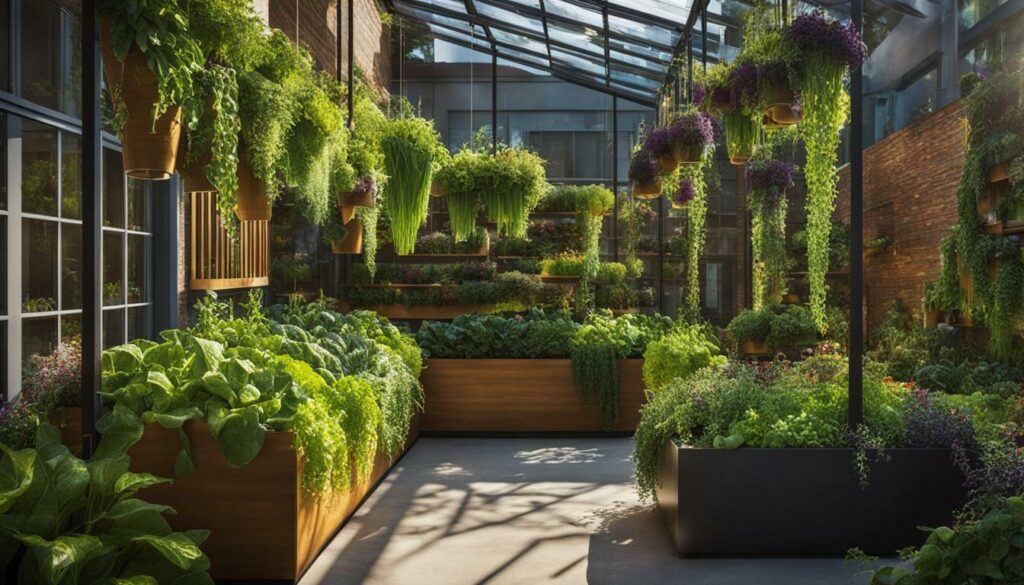
| Benefits of a Hanging Kitchen Garden |
|---|
| 1. Convenient access to fresh herbs and vegetables for cooking |
| 2. Adds a decorative element to your kitchen decor |
| 3. Maximizes limited indoor space |
| 4. Provides a sustainable and cost-effective way to grow your own food |
| 5. Enhances the overall ambiance and air quality in your kitchen |
Start your own hanging kitchen garden today and enjoy the numerous benefits it brings. It’s a simple and rewarding way to incorporate nature into your everyday life and elevate your cooking experience.
Conclusion
Vertical veg garden ideas offer a practical and innovative solution for maximizing your urban outdoor space while promoting eco-friendly living. Whether you have limited space or simply want to explore creative gardening ideas, these vertical garden ideas are sure to inspire and transform your urban green space. With options like ladder planters, upcycled dresser planters, strawberry tower vertical planters, pipe vertical gardens, terracotta pot vertical fence gardens, and more, there are countless ways to grow your favorite vegetables and herbs in a vertical manner.
By utilizing vertical space, you can create a thriving garden in even the smallest of urban areas. These vertical gardening ideas not only maximize your growing potential but also add aesthetic appeal to your outdoor space. From DIY projects like pallet garden planters and hanging kitchen gardens to more intricate designs like hydroponic living walls and trellises for vining plants, there’s a vertical gardening idea to suit every taste and skill level.
Not only do vertical veg gardens allow you to grow a variety of plants in a limited space, but they also promote sustainable living and reduce the carbon footprint. By growing your own vegetables and herbs, you can reduce your reliance on store-bought produce, which often requires extensive packaging and transportation. Vertical gardening also allows for better utilization of water and resources, as the plants are grown closer together and in controlled environments.
So, whether you have a small balcony, a tiny backyard, or even just a wall, vertical veg garden ideas provide a solution for urban dwellers who want to reconnect with nature and enjoy the benefits of fresh, homegrown produce. Get creative, experiment with different vertical gardening ideas, and watch as your urban green space flourishes with life.
What Are Some Creative Vertical Veg Garden Ideas for Urban Spaces?
Looking to spruce up your urban space? Try an urban vertical garden transformation. Hang pocket planters on walls for a colorful display. Use a ladder planter to grow herbs or small vegetables. Incorporate a trellis system for climbing plants. Vertical gardens are an innovative way to maximize space and add greenery to urban areas.
FAQ
Q: What is a vertical gardening idea?
A: A vertical gardening idea is a creative and innovative way to grow plants vertically, maximizing space in small gardens or urban green spaces.
Q: Why is vertical gardening important in urban green spaces?
A: Vertical gardening is important in urban green spaces because it allows individuals to make the most of limited space, promote eco-friendly living, and create beautiful and functional gardens in urban environments.
Q: What are some advantages of vertical gardening?
A: Some advantages of vertical gardening include maximizing garden space, growing more plants in small areas, preventing problems with pests and diseases, and promoting accessibility for people of all ages and abilities.
Q: How much does a trellis for vining plants cost?
A: The cost of a trellis for vining plants can range from $50 to $135 per linear foot, depending on the material used and the size of the trellis.
Q: What are some examples of vining plants that can be grown on a trellis?
A: Some examples of vining plants that can be grown on a trellis include blackberries, grapes, raspberries, clematis, honeysuckle, morning glories, and pole beans.
Q: How much does a living wall of container plants cost?
A: The cost of a living wall of container plants can vary depending on factors such as the size of the wall and the materials used. Ready-made living walls can range from $30 to $80, not including plants.
Q: What are some plants that can be grown in a living wall of container plants?
A: Some plants that can be grown in a living wall of container plants include citrus fruits, figs, strawberries, coleus, geraniums, lettuce, and spinach.
Q: How much does a hydroponic living wall cost?
A: The cost of a hydroponic living wall can range from $500 to $2,000, depending on the size, difficulty, and plants selected. DIY versions made from preserved moss can be less expensive.
Q: What are some plants that can be grown in a hydroponic living wall?
A: Some plants that can be grown in a hydroponic living wall include currants, strawberries, watermelons, impatiens, petunias, basil, parsley, bell peppers, and tomatoes.
Q: How much does a pallet planter cost?
A: The cost of a pallet planter depends on the materials used and the size of the planter. DIY versions can be cost-effective, using repurposed pallets, while ready-made pallet planters can range from $12 to $100.
Q: What are some vegetables that can be grown in a pallet planter?
A: Some vegetables that can be grown in a pallet planter include broccoli, eggplant, and tomatoes.
Q: How much does a hanging kitchen garden cost?
A: The cost of a hanging kitchen garden depends on the materials used and the size of the garden. DIY versions can be affordable, using hanging baskets or containers, while ready-made hanging kitchen gardens can range in price.
Q: What are some indoor plant hanging ideas for a hanging kitchen garden?
A: Some indoor plant hanging ideas for a hanging kitchen garden include hanging herbs, trailing plants, and small succulents.
Q: What is the importance of maximizing space in urban green areas?
A: Maximizing space in urban green areas is important to make the most of limited outdoor space, promote sustainable living, and create beautiful and functional gardens in urban environments.
Q: How can vertical gardening in urban green spaces promote eco-friendly living?
A: Vertical gardening in urban green spaces promotes eco-friendly living by allowing individuals to grow their own food, reduce their carbon footprint, and increase biodiversity in urban environments.
Q: What is the final thought or call-to-action related to eco-friendly living and maximizing outdoor space?
A: The final thought or call-to-action related to eco-friendly living and maximizing outdoor space is to encourage individuals to explore vertical gardening ideas and make the most of their small gardens or urban green spaces to create beautiful and sustainable environments.

